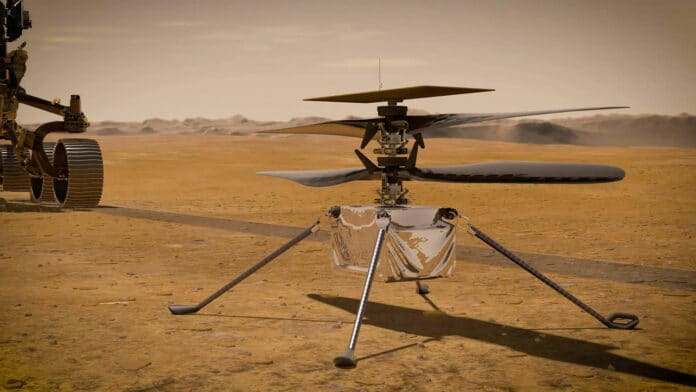For the first time in history, two planets have been home to testing future aircraft designs. Recently, a new rotor was tested in the 25-foot Space Simulator at NASA’s Jet Propulsion Laboratory in Southern California, which could potentially be used in next-generation Mars helicopters.
During the three-week-long test, the carbon-fiber blades were spun at ever-higher speeds and greater pitch angles to see if they would remain intact as their tips approached supersonic speeds. The blades, which are longer and stronger than those used on NASA’s Ingenuity Mars Helicopter, reached Mach 0.95 during the test. In the meantime, the Ingenuity Mars Helicopter has set new records for altitude and airspeed on the Red Planet in the name of experimental flight testing.
“Our next-generation Mars helicopter testing has literally had the best of both worlds,” said Teddy Tzanetos, Ingenuity’s project manager and manager for the Mars Sample Recovery Helicopters. “Here on Earth, you have all the instrumentation and hands-on immediacy you could hope for while testing new aircraft components. On Mars, you have the real off-world conditions you could never truly re-create here on Earth.” That includes a whisper-thin atmosphere and significantly less gravity than on Earth.
NASA is testing the next-generation carbon fiber rotor blades that could enable larger and more advanced Mars helicopters. The new blades are almost 4 inches (more than 10 centimeters) longer than Ingenuity’s blades, with greater strength and a different design. However, the challenge is that as the blade tips approach supersonic speeds, vibration-causing turbulence can quickly get out of hand.
Engineers used JPL’s 25-foot wide, 85-foot-tall (8-meter-by-26-meter) space simulator to simulate the Martian atmosphere on Earth, where Surveyor, Voyager, and Cassini were also tested. The team monitored sensors, meters, and cameras for three weeks in September as the blades endured run after run at ever-higher speeds and greater pitch angles.
“We spun our blades up to 3,500 rpm, which is 750 revolutions per minute faster than the Ingenuity blades have gone,” said Tyler Del Sesto, Sample Recovery Helicopter deputy test conductor at JPL. “These more efficient blades are now more than a hypothetical exercise. They are ready to fly.”
NASA’s Ingenuity helicopter has been surpassing expectations since it achieved the first powered flight on another planet in April 2021. In late 2022, it set an altitude record of 46 feet (14 meters) above the Martian surface, and in April 2023, it celebrated its 50th flight by breaking that record with a height of 59 feet (18 meters).
Over the past two-and-a-half years, it has completed 66 flights, which is remarkable, given that engineers only planned for five flights. Recently, Team Ingenuity has been taking their solar-powered rotorcraft out for a spin like never before while covering new ground and relaying valuable data that may prove valuable for mission designers to develop future flying models.
“Over the past nine months, we have doubled our max airspeed and altitude, increased our rate of vertical and horizontal acceleration, and even learned to land slower,” said Travis Brown, Ingenuity’s chief engineer at JPL. “The envelope expansion provides invaluable data that can be used by mission designers for future Mars helicopters.”
Ingenuity flights are limited by available energy and motor-temperature considerations, typically lasting around two to three minutes. Flying too fast can confuse the onboard navigation system, which uses a camera to recognize rocks and other surface features as they move through its field of view.
To achieve a higher maximum ground speed, the team sends commands for Ingenuity to fly at higher altitudes, which keeps features in view longer. The helicopter also established a new altitude record of 78.7 feet (24 meters) and set a speed record of 22.3 mph (10 meters per second).
The team has also been experimenting with Ingenuity’s landing speed, demonstrating that it could land at speeds 25% slower than it was originally designed to land at Flights 57, 58, and 59.
In December, after solar conjunction, Ingenuity is expected to perform two high-speed flights during which it will execute a special set of pitch-and-roll angles designed to measure its performance.
“The data will be extremely useful in fine-tuning our aero-mechanical models of how rotorcraft behave on Mars,” said Brown in the press release. “On Earth, such testing is usually performed in the first few flights. But that’s not where we’re flying. You have to be a little more careful when you’re operating that far away from the nearest repair shop because you don’t get any do-overs.”
